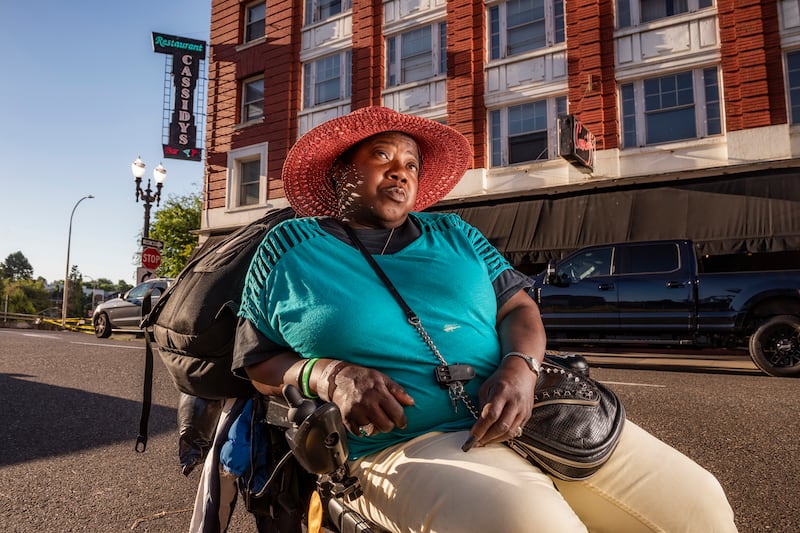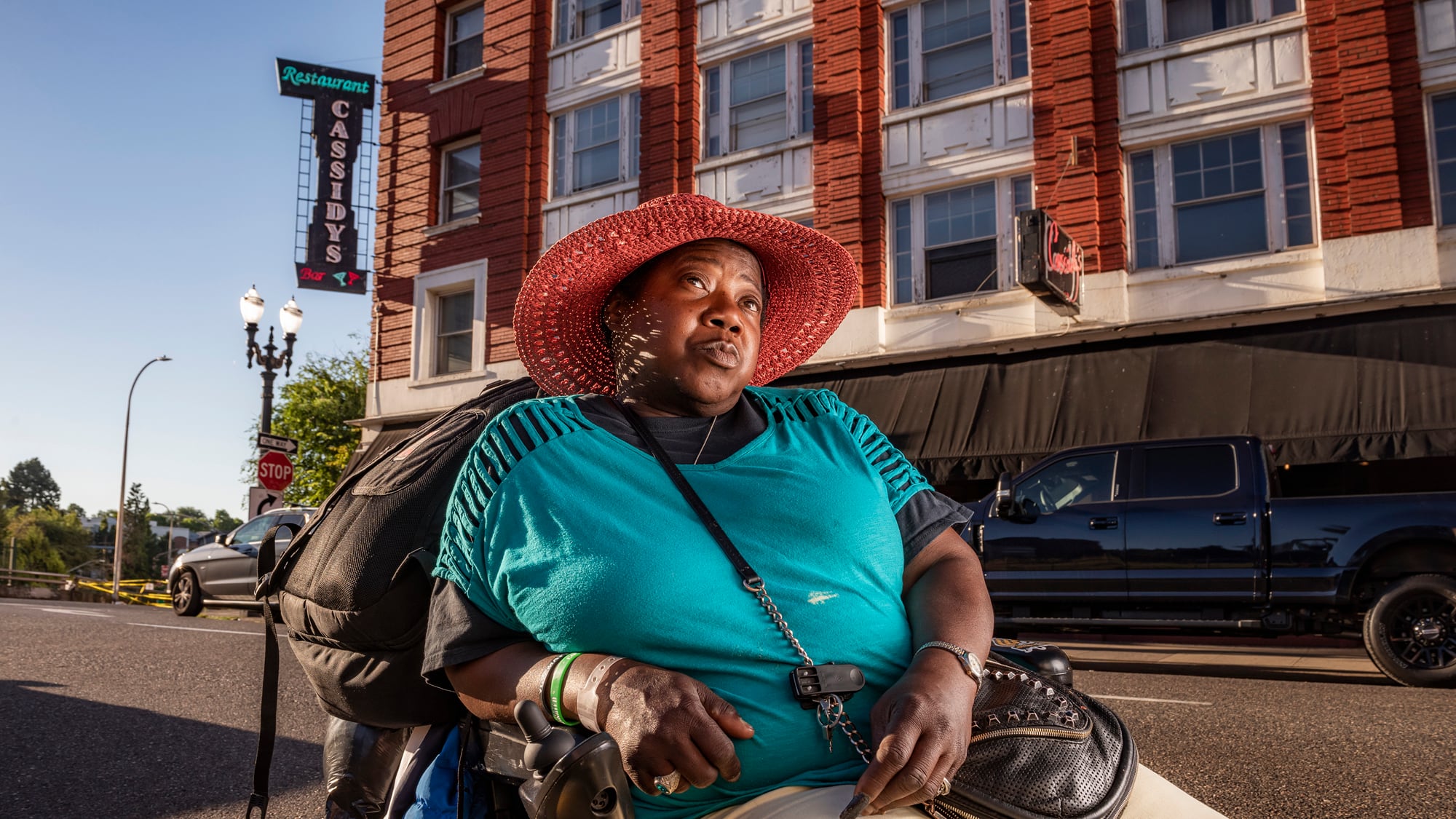For much of the past year, Josephine Allen slept outside, across the street from her old apartment building.
Her tent and wheelchair were perched on a patch of dirt above Interstate 405 on Portland’s West End. This gave her a full view of the Taft Home, her residence until eight months ago.
She once lived in Apartment 341, one of 70 units that for seven decades provided beds for low-income seniors with mental or physical disabilities.
The Taft Home, which stands at Southwest 13th Avenue and Washington Street, next to the Crystal Ballroom, is owned by Reach Community Development Corporation, a nonprofit whose mission is to house the less fortunate. It does so with large amounts of financial support from the city and state. And yet, since December of last year, through freezing cold, endless spring rain and the current heat spell, the Taft’s 70 beds have served…nobody.
The building, a four-story residential hotel built in 1906 and listed in the National Register of Historic Places, is not in structural disrepair. Yet those units sit unused.
“We’re in a full-scale crisis, all up and down the yin-yang,” says Jason Renaud, director of the Mental Health Association of Portland, speaking of the Taft’s monthslong vacancy. “We need to be using any bit of spare architecture we can get our hands on.”
Paula Carder, director of Portland State University’s Institute on Aging, says the fact that the Taft Home stands vacant amid extraordinary need for shelter undercuts public officials’ promise of urgency in dealing with the housing crisis.
“Why is there a person in a wheelchair trying to live in a tent and get by on the streets?” Carder asks. “This is why: There’s a huge need for affordable housing, and it’s just sitting there.”
WW spent more than two months reviewing public records and speaking to state regulators, city officials, and former tenants and staffers about what happened inside the Taft Home. The story of its demise reveals a web of nonprofits, private caretakers, and public bureaucrats who largely waited on each other to step in as things went wrong.
Their collective inaction hints at why the housing crisis deepens even as more money than ever is available to remedy it.

Eight months ago, Josephine Allen, who grew up in Portland and graduated from Jefferson High School before going on to work as a railroad clerk, was living at the Taft. Music from the bar below, Scooter McQuade’s, caused the walls of her room to vibrate. She swore her floor was off kilter, cockroaches skittered across the floor, and she felt disrespected by some caretakers—but still, it was home. “Christmas,” she recalls, “was just beautiful.”
Allen, 58, spent decades in an abusive relationship after having four children. When she escaped her abuser in 2014, she lived on the streets for a time, coped with the trauma by drinking, and got a room at the Taft around 2018.
It was one of just six facilities in Portland and Gresham that housed people with complex mental, behavioral and physical needs, supported mostly by Medicaid.
Each resident had their own room. The Taft was staffed by a resident nurse, caretakers who helped bathe, transport and feed residents, and medical technicians who administered medications. Physical therapists, doctors and caseworkers would regularly visit.
A kitchen on the ground floor prepared dishes like Beefy Baked Ravioli and Tangy Fruit Salad. Staffers would occasionally fetch snacks or soft drinks for their favorite residents from the nearby Whole Foods.
Darwin Davis, 71, lived on the streets before moving into the Taft in 2006. He calls it “the most perfect place I’ve ever been in.”
Still, according to former employee Ward Stalding, a day without some sort of incident was rare. There were often physical fights between residents, mental health crises, and emotional outbursts. Drug use in common spaces without consequence was rampant.
Mark Malicoat, a former eight-year resident with a rare nerve condition who’s been living in a nearby hotel since the Taft closed, described the home as “bedlam”: “The minute I got in there, I wanted to run out the door.”
The condition of the building declined in its last two or three years, according to four former employees WW interviewed.
Photos provided to WW show staffers asleep on chairs in the break room during work hours. Narcotics strewn on tables. A door with a punched-out plank.
Stalding, who worked at the Taft on and off beginning in 2005, says more residents started abusing drugs and alcohol.
All four employees say residents were difficult, but that it was no excuse for how certain staff treated them. A revolving door of young caretakers meant residents were often presented with new faces assigned to care for them.
“They were treated absolutely poorly,” Stalding says.
The Oregon Department of Human Services licenses and regulates facilities like the Taft Home. The state agency has the authority to investigate complaints, issue civil penalties and revoke licenses.
In 2021, DHS issued the Taft Home nine civil penalties and 21 licensing citations. The state alleged the Taft Home was neglecting basic tasks like having enough staff on site, administering medications on schedule, and keeping the building free of pests and grime.
Reach CDC, the housing nonprofit that owns the Taft, leased the building to a private senior living operator, Concepts in Community Living, that operated the facility.
CCL, based in Clackamas, runs nine facilities for seniors across Oregon—and more in Washington and California.
It was co-founded in 1988 by Keren Brown Wilson, who’s largely credited for creating the first assisted living community in the United States. In 1994, she transferred control of CCL to her co-founder husband, Michael DeShane, who’s still the president and owner.
CCL’s annual revenue is estimated at $17 million a year by ZoomInfo.
The Taft Home was its most troubled facility. By comparison, none of its other Portland-area facilities had more than two violations in 2021.
Last July, the state told the Taft it couldn’t accept any more residents until it addressed issues that put residents “at risk of immediate jeopardy” and were “likely to cause serious injury, serious harm, serious impairment, or death to a resident or residents,” documents show.
DHS spokeswoman Elisa Williams says placing such conditions on a senior living center is “not routine.” It means something going on there is alarming enough to deem the facility a risk to the very people who call it home. Last year, 24 of the 560 assisted living and residential care facilities in Oregon had conditional licenses.
A month later, DHS found the same problems again —and threatened to revoke the Taft Home’s license. CCL had two options: Fix the problems or close.
Concepts in Community Living chose the latter option. The Taft Home would close for good on Dec. 1.
WW broke news of the closure Dec. 3. CCL told WW at the time that making the required remedies—which, according to state documents, included pest control, administering medications on schedule, putting a stop to hoarding, and fixing taped floorboards—was impossible because of a “workforce shortage, the aging facility, and the need for significant resources for improvements.”
Since then, CCL executives declined an interview with WW and refused to answer multiple rounds of written questions.
Residents, meanwhile, were scattered to the wind.
They were sent to 26 different facilities across the state, according to a resident placement list shared with WW by a former employee. Two with severe mental illnesses were sent to motels to await housing placements, according to employees. And a few refused housing because they were so upset and therefore were not placed.
Marisa Espinoza, a policy and systems advocate for Northwest Pilot Project, a nonprofit that connects low-income seniors to housing, says residents of the Taft are perhaps the toughest Portlanders to find suitable housing for. Many of the residents have a triple-whammy of issues: physical disabilities, mental illness and addiction. They’re also poor.
“We simply do not have enough places like the Taft. We literally don’t have anywhere where people with these needs to go,” Espinoza says. “They may cycle in and out of the ER, jail, the streets; they might even go into a facility temporarily.”
Davis was able to find a bed at an assisted living home in Redmond—a three-hour drive from Portland, where he lived at the Taft for 15 years and hoped to live for the rest of his life.
He calls the closure “the worst thing I’ve ever been involved in.”
Allen, who’s Black and wheelchair-bound, went first to an adult foster home in Salem. She left after two nights, came back to Portland, and moved to the patch of dirt across the street from the Taft Home. Her partner, David, lived there, too, along with three or four others. You could see her most mornings if you drove west on Burnside and glanced left as you passed Everyday Music.
She lit fires during the cold months with tin cans and rubbing alcohol inside her tent. The cold badly inflamed her arthritis. She got a lung infection because of the fumes, spent time at the hospital, and landed back at the camp. Rats chewed through most of her belongings.
“I was afraid when it closed because I thought the streets was gonna be worse,” Allen says. “And it was.”

The Taft Home stands vacant now. Its doors are boarded up with plywood painted rust red. The blinds are drawn in every apartment window. The only thing that’s changed since December is that Cassidy’s Restaurant reopened on the ground floor in May.
The building was not shuttered for any irreparable structural dangers. While it is old and could do with some improvements, it simply requires a new operator who can care for its occupants.
In 2018 and 2020, Portland voters approved multimillion-dollar ballot measures to build affordable housing and keep people in existing housing with rental assistance and behavioral health services. Those are the services needed by the people who lived in the Taft Home.
Yet eight months after its operator quit, the hotel remains empty.
Multnomah County Commissioner Sharon Meieran, who’s running for county chair, says the vacancy “makes no sense to me.”
“One just assumes that when there are housing units available during a crisis, that they would be put to good use,” Meieran says. “But I’ve learned that no one should assume.”
WW wanted to know who would take responsibility for the shuttering of the Taft and the failure to reopen it sooner.
How about the building’s owner? Reach CDC, which purchased the hotel for $362,000 in 1986.
One of the biggest affordable housing developers in the city, Reach CDC houses more than 3,500 people in Portland and Vancouver, Wash. Reach’s total revenue in 2020 was $21 million. Its CEO and president, Dan Valliere, made $178,000 that year.
The nonprofit responded by email to written questions.
Reach spokeswoman Lauren Schmidt says the Taft Home has stood empty for so long because Reach was waiting for CCL to vacate the building, and is still waiting for the results of a capital needs report it commissioned in January to show what repairs and maintenance should be done.
“Before any plans or best uses can be determined, Reach and the city will need to review and assess findings from the report,” Schmidt adds.
Even as she pointed to the capital needs report as a condition for moving people back into the Taft, Schmidt conceded the building is structurally sound. “We did not say the building was unsafe structurally,” she wrote.
Reach did not seek another operator, Schmidt says.
So WW moved on—to the Portland Housing Bureau.
City Hall has an unusual level of control over the Taft Home because the owner, Reach CDC, borrowed city money for renovations in 1998.
As of 2020, Reach still owed the Portland Housing Bureau $292,000 in loan repayments. (Update: Reach owes the Portland Housing Bureau an additional $654,000 for another loan it received in 1988 for the Taft, according to the housing bureau after press deadline.)
Yet Housing Bureau officials say they had little control over Reach’s actions.
“[The Housing Bureau] does not dictate to affordable housing sponsor/owners what can or cannot be done to their properties when unoccupied,” spokesman Gabriel Mathews says. (Documents show, however, that Reach cannot sell the building without city approval until 2028, and cannot change the use of the building without the bureau’s permission.)
Mathews adds that neither the Housing Bureau nor Reach were privy to state regulators’ crackdown on the Taft Home’s operator, and that the condition CCL left the building in wasn’t fit to immediately inhabit.
In other words, the bureau said it had no idea what was happening in the Taft Home until the problem was too far gone to quickly fix. (When asked if Reach was privy to DHS reports on the Taft as they came out, Schmidt said Reach did not understand the question and declined to comment further on the closure.)
Every elected official in the city says they’re doing everything in their power to remedy the housing crisis. What about a 70-unit apartment building 13 blocks from City Hall?
WW asked City Commissioner Dan Ryan, who oversees the Portland Housing Bureau and whose chief project is a three-year, $44 million plan to build six “safe rest villages” throughout the city that will house up to 50 people each.
Ryan’s office declined repeated requests by WW for a phone call with the commissioner.
Ryan said in a statement he would “be thrilled to support swift and thorough action” at the Taft Home once Reach’s report is completed. He did not answer questions about whether he should be placing more pressure on Reach to house people in its building.
Mayor Ted Wheeler has also said he’s acting with urgency to help homeless Portlanders. Just this year, he started making emergency declarations to increase sweeps of homeless camps, clear highways of tents, and even seize a private plot of land for one of Ryan’s villages using eminent domain.
WW asked him if he would resume control over a building that the city has financial stake in. He didn’t answer the question.
“I look forward to learning more about the viability of the vacant Taft Home building after further review and analysis is complete,” Wheeler said in a statement.
Carder, who runs PSU’s center on aging, says the lackadaisical pace might be due to nobody stepping in and taking the lead.
“It seems like it would be easy, but our process shuts things down. It slows things down so much,” Carder says. “If Reach has a lease to continue providing housing in the Taft for another six years, where is the pressure for that?”
As for Allen, her life has improved somewhat in recent weeks. She has found a shelter bed in East Portland.
She still feels betrayed by the last people who promised her a roof over her head. “They didn’t care about none of us,” Allen says.

Trial by Fire
Records and interviews show that the mental deterioration of a Taft Home resident last summer culminated in a blaze that forced the evacuation of the entire building. Twenty-four days later, police arrested her.
On the morning of June 28, 2021, a Taft resident dialed the Multnomah County mental health crisis line and told operators she was thinking about committing suicide by either lighting herself on fire or jumping out the window that day.
The county alerted Taft management, who, according to Department of Human Services investigation notes obtained by WW, knocked on her door several times, but she never opened the door.
According to the DHS notes, employees told the investigator that they didn’t need to check on her because her behavior was just “how she is,” not a “true mental health” disorder.
But state investigative documents said the facility had documented that she did, in fact, suffer from a mental health disorder.
At 6:15 pm, smoke began emerging from a second-floor room and filled the hallway. Firefighters arrived at 6:21 pm.
Residents were shuffled out the exits; residents in wheelchairs were wheeled out to the fire escape. Two went to the hospital because of medical emergencies, including the resident, who, according to a Portland Fire & Rescue report, was found in her room. (The resident, whose name WW is withholding because she just recently got placed in stable housing, maintains she did not start the fire.)
The state launched an investigation into the Taft Home immediately after the fire due to a complaint filed by the woman’s daughter. Some of the most damning findings about conditions in the building emerged from that probe. Concepts in Community Living, the private company that operated the Taft, announced just one month later it would close the home at the end of the year.
The resident was in the hospital for 24 days, during which time the Taft evicted her.
Police arrested her at the hospital on July 22. She’s wearing a hospital gown in her mug shot. She was kept overnight at the Multnomah County Detention Center on arson charges and discharged to the streets the following morning. Police knew she had nowhere to go, according to a recognizance report.
The police referred the case to the Multnomah County District Attorney’s Office, which declined to prosecute the case, citing insufficient evidence that she had started the fire.
She just recently moved into an apartment of her own after a year living on her daughter’s couch.
Her daughter visited her there on a recent Friday. It was her mom’s birthday. They rode a bus to the grocery store, where her daughter bought her almond milk, raw sugar, and a shower curtain using BottleDrop vouchers.
“Some people might not understand that,” her daughter says, “but for us, the normalcy and stability is huge because we haven’t had that for so long.”
This article was published with support from the Jackson Foundation, whose mission is: “To promote the welfare of the public of the City of Portland or the State of Oregon, or both.”

